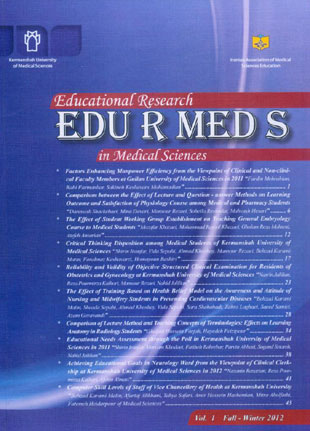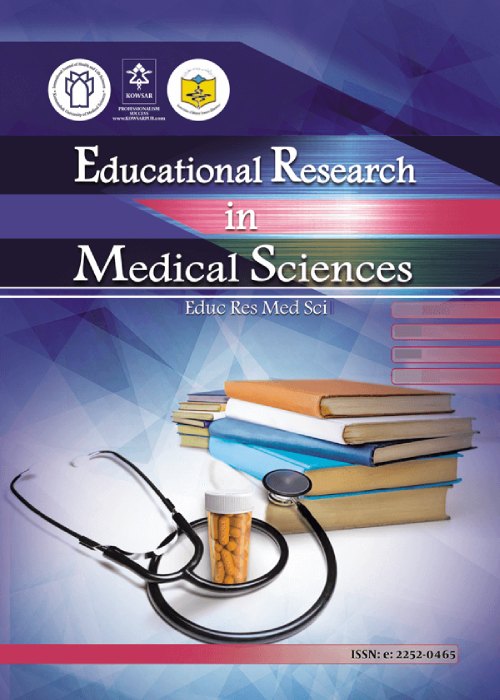فهرست مطالب

Educational Research in Medical Sciences
Volume:1 Issue: 2, Dec 2012
- 50 صفحه،
- تاریخ انتشار: 1392/01/25
- تعداد عناوین: 10
-
-
Page 1IntroductionThere are various factors that affect manpower efficiency. Identification of the most important and influential factors on efficiency is quite essential. Analysis of factors affecting manpower efficiency from the viewpoint of clinical and non-clinical faculty members at Guilan University of Medical Sciences in 2011.MethodsThis descriptive, analytical, cross-sectional study was performed in October and November in 2011. The study sample consisted of 186 faculty members, including 128 clinical and 58 non-clinical. Instruments used to collect library data were questionnaire and field studies. Exploratory factor analysis with Varimax rotation was utilized to determine the factors influencing manpower efficiency as well as loading level of each of the variables.ResultsAmong clinical faculty members, 70.66% of changes in manpower efficiency, and among non-clinical faculty members, 79.57% of changes in manpower efficiency were explained by 9 and 8 factors, respectivelyConclusionStaff empowerment and organizational culture were recognized as the most important factors enhancing manpower efficiency from the viewpoint of clinical and non-clinical faculty members, respectively.Keywords: Efficiency, Manpower, faculty
-
Page 6IntroductionConsidering the efficiency of active teaching methods, current study is designed to compare the effect of lecture and question-answer methods on learning outcome and satisfaction of physiology course among medical and pharmacy students.MethodsIn this semi-experimental study, medical and pharmacy students which have been registered in physiology course, divided randomly into two groups. Some topics of physiology with the same content were taught for both groups. The difference was that in the test group, question-answer method was used. In the next meeting, test and control groups were displaced and the same test was performed for all students at the end of each session. Totally, 8 sessions run in this way and the average test scores in two groups were compared. We used a questionnaire to compare the student opinion about these two methods. Content validity of the questionnaire was determined and its reliability was calculated by using Cronbach''s alpha.ResultsThe results showed that the mean percentage of correct answers to final exam questions in test groups of medical (78±2.06%) and pharmacy students (55.02±3.89%) was significantly greater than control groups (65±2.64%, 42.41±3.22% respectively) with P value of 0.0001 and 0.018, respectively. More than 90% of students preferred this method to the traditional method.ConclusionOur findings showed that using simple active question-answer method would increase students’ satisfaction and learning outcome at physiology course. Thus, we recommend using of this method for education of other basic science courses.Keywords: Lecture, Teaching Methods, Medical students, Pharmacy students
-
Page 12IntroductionQuantitative and qualitative enhancement of educational activities is an essential issue. Learners’ cooperation in the teaching process in order to increase teaching effectiveness and promotion is considered significant. The aim of the present study was to determine the effect of establishment of student working group on the teaching general embryology course to medical students.MethodsTen students (1%) of medical embryology course were selected to analyze the topics to be taught before each session according to lesson plan, and observe the whole teaching process during lesson presentation. Then, having asked the other students’ viewpoints and discussing with one another, they provided the teacher with a written report on the strengths and weaknesses of the teaching and its problems. The teacher analyzed the problems proposed by the working group to improve teaching process in the next session. At the end of the semester, a questionnaire was administered to all the participants. Data were analyzed using descriptive statistics.ResultsThe mean of students’ scores was 74.26%. The most important findings obtained in this study included positive role of film projection in teaching the materials (95.34%), significance of presentation of various pictures from different books (88.4%), changing students’ attitude toward application of embryology in different diseases (86%), and repetition of previous session’s pictures (83.75%). The weak points mentioned, however, were physical problems of the classroom and deficiency of audio visual equipment.ConclusionStudent working group has a positive impact on the teaching medical general embryology.Keywords: Teaching, Embryology, Medical students
-
Page 17IntroductionCritical thinking as a process of purposeful self-regulatory judgment leads to problem solving and correct decision making in individuals. In the modern world, health care faces rapid change and burgeoning amount of knowledge. Possessing critical thinking is essential for individuals in health care centers, specially when they are forced to solve clinical problems. The aim of this study was to evaluate critical thinking disposition among medical students in various levels of education.MethodsIn this descriptive, cross-sectional study, we determined critical thinking disposition among 289 medical students of Kermanshah University of Medical Sciences. The students were studying at different levels of general physician education. In Iran general physician education divided into four levels; basic sciences, physiopathology courses, clerkship and internship. They were selected using stratified sampling. Data were collected using a questionnaire that consisted of two parts; demographic information of the participants and California Critical Thinking Disposition. To analysis the data, both descriptive and inferential statistics (One-way ANOVA) were employed using SPSS-16 software.ResultsOur findings indicated that 98.6% of the students lacked critical thinking disposition, 1.4% were ambivalent disposition and no one had positive disposition to critical thinking. The highest acquired score of critical thinking was for truth-seeking (20.4%) and the lowest score acquired for analyticity (4.8%). The results revealed that there was no statistically significant difference between mean score of participants with regards to their critical thinking disposition in various educational levels.ConclusionThe findings of this study indicated that medical students lacked appropriate critical thinking disposition.Keywords: Medical students, Clinical judgment, Thinking
-
Page 23IntroductionObjective structured clinical examination (OSCE) is used for the evaluation of the clinical competence in medicine for which it is essential to measure validity and reliability. This study aimed to investigate the validity and reliability of OSCE for residents of obstetrics and gynecology at Kermanshah University of Medical Sciences in 2011.MethodsA descriptive-correlation study was designed and the data of OSCE for obstetrics and gynecology were collected via learning behavior checklists in method stations and multiple choice questions in question stations. The data were analyzed through Pearson correlation coefficient and Cronbach''s alpha, using SPSS software (version 16). To determine the criterion validity, correlation of OSCE scores with scores of resident promotion test, direct observation of procedural skills, and theoretical knowledge was determined; for reliability, however, Cronbach''s alpha was used. Total sample consisted of 25 participants taking part in 14 stations. P value of less than 0.05 was considered as significant.ResultsThe mean OSCE scores was 22.66 (±6.85). Criterion validity of the stations with resident promotion theoretical test, first theoretical knowledge test, second theoretical knowledge, and direct observation of procedural skills (DOPS) was 0.97, 0.74, 0.49, and 0.79, respectively. In question stations, criterion validity was 0.15, and total validity of OSCE was 0.77.ConclusionFindings of the present study indicated acceptable validity and reliability of OSCE for residents of obstetrics and gynecology.Keywords: Validity, reliability, Evaluation, Residency, Gynecology
-
Page 28IntroductionAmong the most important strategies for controlling cardiovascular diseases are preventive steps such as training and enhancing the awareness level, and preventive skills for protecting individuals. The aim of this study was to investigate the effect of training based on Health Belief Model on the awareness and attitude of nursing and midwifery students in preventing cardiovascular diseases.MethodsIn this quasi-experimental study, 110 participants were selected from nursing and midwifery students during 2010 and 2011. They had not passed courses related to cardiovascular diseases. Four 2-hour training sessions were designed based on Health Belief Model. Demographic information questionnaire had questions related to awareness, perceived susceptibility, perceived severity, perceived benefits, perceived barriers and action guide which was completed before training and six weeks after training by questionnaire and interview. Data was analyzed using SPSS 16 software and paired T-test.ResultsThe findings indicated that the mean scores of the students’ awareness before and after training were 14.5 and 16.1, respectively and there was a statistically significant difference between them. The findings also showed that the mean scores of the students’ attitude before and after training were 41.9 and 41.8, respectively and there was no statistically significant difference between them.ConclusionSince changing in behavior is the result of changing in attitude, in order to change the attitude of the people about health issues such as health behavior toward cardiovascular diseases, training should be considered as a continuous procedure.Keywords: Training, Attitude, Awareness, Cardiovascular diseases
-
Page 34IntroductionThe aim of this study was to compare the effects of lecture and teaching terminology methods on learning anatomy in radiology students.MethodsFifty freshmen were randomly divided into two groups: control and experimental. The control group was taught through traditional method and the experimental group via teaching anatomy concepts and terminologies. Students were evaluated through mid-term and final term examinations.ResultsFinal term scores in the experimental group were significantly higher than those of control group.ConclusionThis study indicated that teaching anatomy terminologies motivates students to study more and prevents them from memorizing the materials.Keywords: Anatomy, Terminology, Learning, Students
-
Page 37IntroductionSince educational empowerment of the faculty members of universities of medical sciences depends on our understanding of their educational needs. The present study aimed to investigate the educational needs of the faculty members of Kermanshah University of Medical Sciences in 2011 in order to plan the appropriate training workshops.MethodsIn this descriptive study, the poll was used to accomplish the abovementioned objective. A questionnaire was designed and delivered to the faculty members to fill out, and then was returned to education development center after being completed. Descriptive statistics to determine educational needs of the faculty members.ResultsOur findings indicated that from all the returned questionnaires, 60% from medical faculty and the rest from other faculties, most educational needs in the view of the faculty members included creativity and innovation, and professional ethics workshops.ConclusionWith regard to the activities of education development centre, it seems that the individuals involved in education have different needs compared to the previous years and are interested in learning new materials.Keywords: Needs assessment, Education, Workshop


